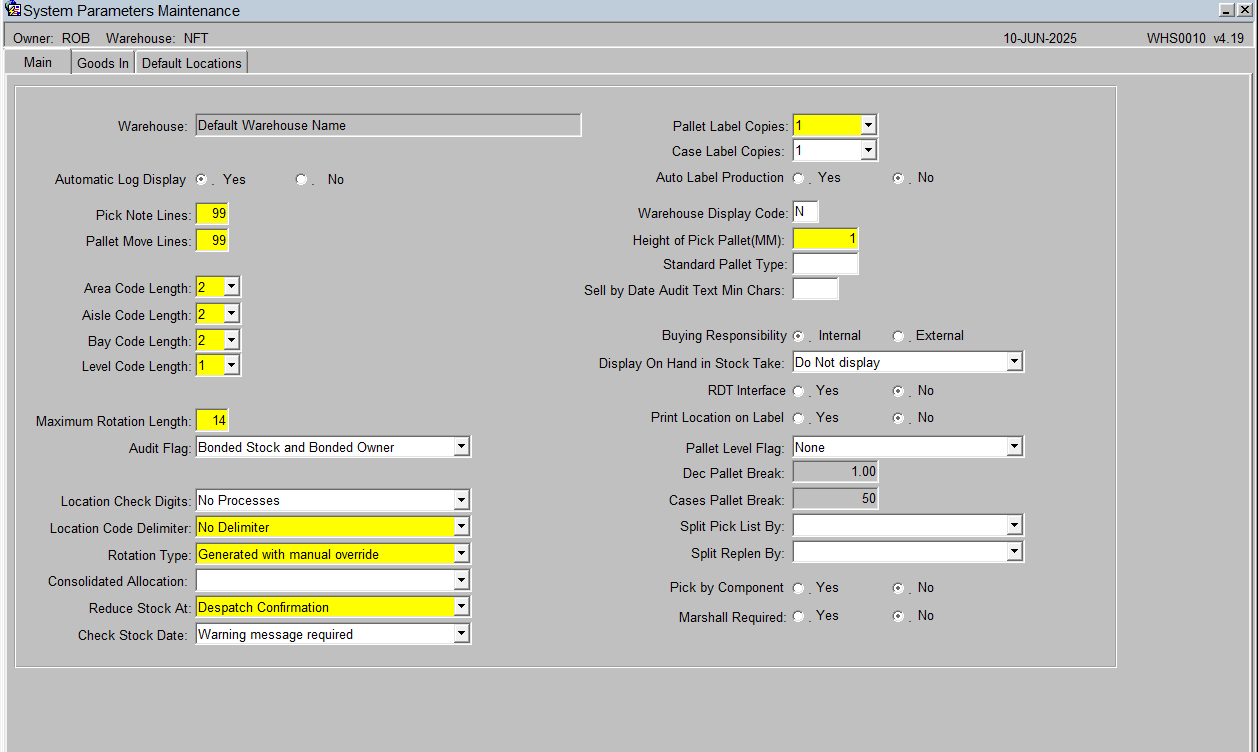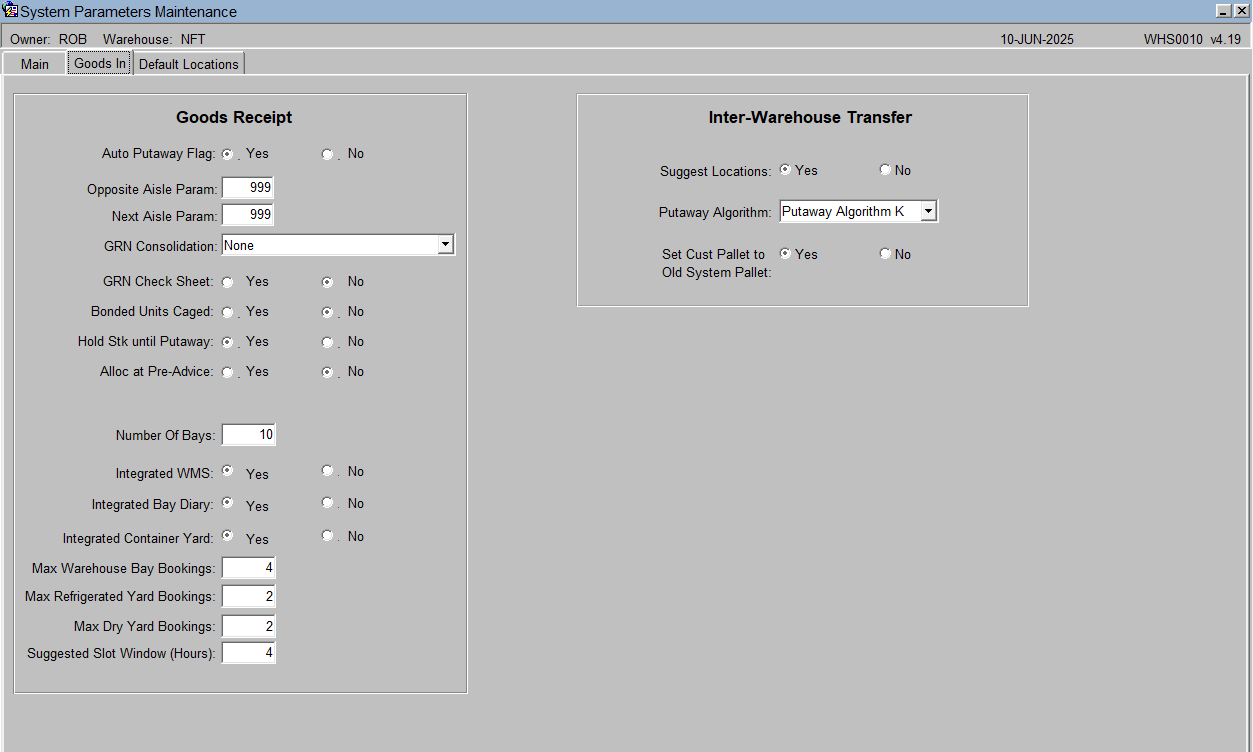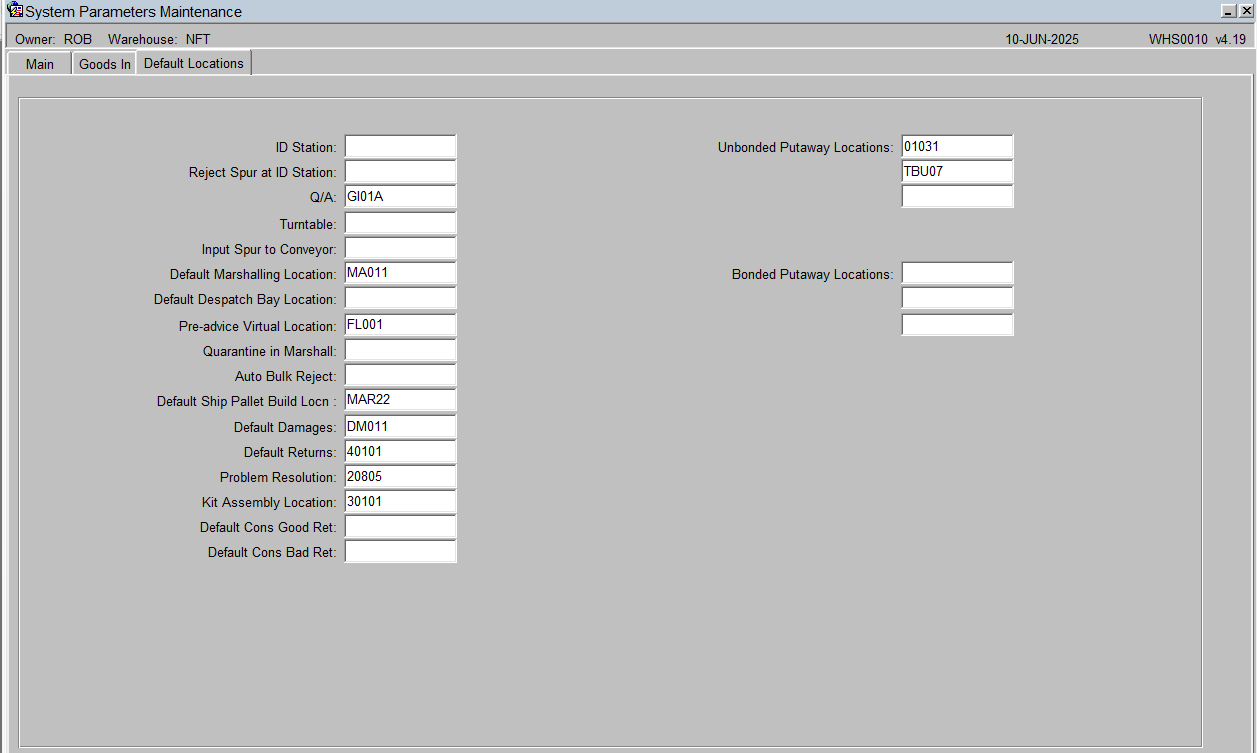WHS0010: Difference between revisions
No edit summary |
m (Minor formatting change) |
||
| Line 1: | Line 1: | ||
==System Parameters (WHS0010)== | |||
This screen maintains all the static formats that will be used to set up the warehouse. There are three tabs in all. This page will detail the setup required within the MAIN tab. | |||
Warehouse specific information is maintained in this screen. The above set up is the generic set up for a basic warehouse. Please see information at the end of this user guide for more details on the client specific flags | |||
Note, again, the user must be logged in as the correct warehouse in order to make changes | Note, again, the user must be logged in as the correct warehouse in order to make changes | ||
| Line 27: | Line 29: | ||
===GOODS IN TAB=== | |||
The Goods In tab of the System Parameters screen specifies what functionality during goods receipt you wish to use. | The Goods In tab of the System Parameters screen specifies what functionality during goods receipt you wish to use. | ||
[[Image:sysgi.png]] | [[Image:sysgi.png]] | ||
| Line 43: | Line 42: | ||
* The Hold Stk until Putaway flag should always be set to ‘Y’ If this is not set, stock received on a goods receipt could be ordered before it has been physically located within the warehouse | * The Hold Stk until Putaway flag should always be set to ‘Y’ If this is not set, stock received on a goods receipt could be ordered before it has been physically located within the warehouse | ||
===DEFAULT LOCATIONS TAB=== | |||
The Default Locations tab is used to determine which locations are to be used during certain automatic processes throughout the system. | The Default Locations tab is used to determine which locations are to be used during certain automatic processes throughout the system. | ||
Note, this screen cannot be set up until the location codes have been created. The user normally saves the first two tabs of System Parameters, then returns to complete this tab once the necessary locations have been created | Note, this screen cannot be set up until the location codes have been created. The user normally saves the first two tabs of System Parameters, then returns to complete this tab once the necessary locations have been created | ||
[[Image:sysdef.png]] | [[Image:sysdef.png]] | ||
| Line 59: | Line 54: | ||
* Only the Default Marshalling Location is used within generic basic warehouse set-up. Any other locations required will be determined by the client specific processes | * Only the Default Marshalling Location is used within generic basic warehouse set-up. Any other locations required will be determined by the client specific processes | ||
* Note, failure to enter a marshalling location here will mean that it will be required to be manually entered for each allocation run. | * Note, failure to enter a marshalling location here will mean that it will be required to be manually entered for each allocation run. | ||
Revision as of 08:39, 10 June 2025
System Parameters (WHS0010)
This screen maintains all the static formats that will be used to set up the warehouse. There are three tabs in all. This page will detail the setup required within the MAIN tab.
Warehouse specific information is maintained in this screen. The above set up is the generic set up for a basic warehouse. Please see information at the end of this user guide for more details on the client specific flags
Note, again, the user must be logged in as the correct warehouse in order to make changes
Note:
- Auto Log Display determines whether the user wishes to see the allocation log once a set of orders has been allocated
- Pick Note and Pal Move Lines specifies the number of lines allowed on a printed pick or move note
- The Area, Aisle, Bay and Level lengths are used to determine the format of the location codes. I.E. A location code of AA-01-1A would have an aisle, bay and level length of 2 each (the area code is not included)
- Max. Rotation Length is the length of the system generated rotation number
- Loc Delimiter is the symbol used to separate the aisle, bay and level within the location code (for our example, the delimiter would be ‘-’
- The Rotation Type is how the system generates the rotation number, or whether it is to be manually entered by the user.
- Reduce Stk At will determine when stock is downdated during the order cycle. Note, this is extremely important, if you choose ‘Pick Confirmation’ Despatch will not be feasible .
GOODS IN TAB
The Goods In tab of the System Parameters screen specifies what functionality during goods receipt you wish to use.
Note:
- The Auto Putaway flag must only be set to ‘Y’ if you wish the system to dictate where stock is located during the goods receipt process
- The Opposite and Next Aisle Param fields are to determine how many locations you wish the system to search before moving to the next, or opposite aisle during Auto Putaway
- The Hold Stk until Putaway flag should always be set to ‘Y’ If this is not set, stock received on a goods receipt could be ordered before it has been physically located within the warehouse
DEFAULT LOCATIONS TAB
The Default Locations tab is used to determine which locations are to be used during certain automatic processes throughout the system.
Note, this screen cannot be set up until the location codes have been created. The user normally saves the first two tabs of System Parameters, then returns to complete this tab once the necessary locations have been created
Note:
- Only the Default Marshalling Location is used within generic basic warehouse set-up. Any other locations required will be determined by the client specific processes
- Note, failure to enter a marshalling location here will mean that it will be required to be manually entered for each allocation run.


